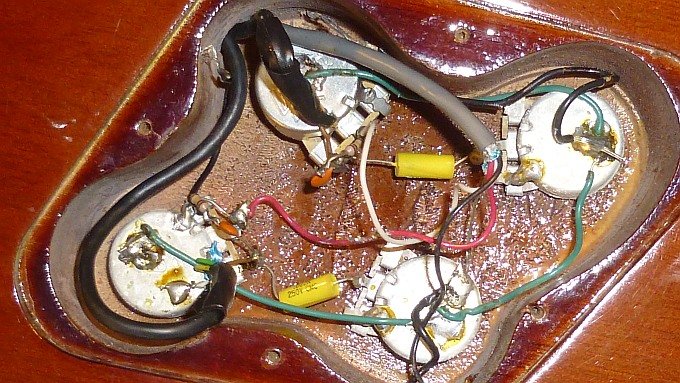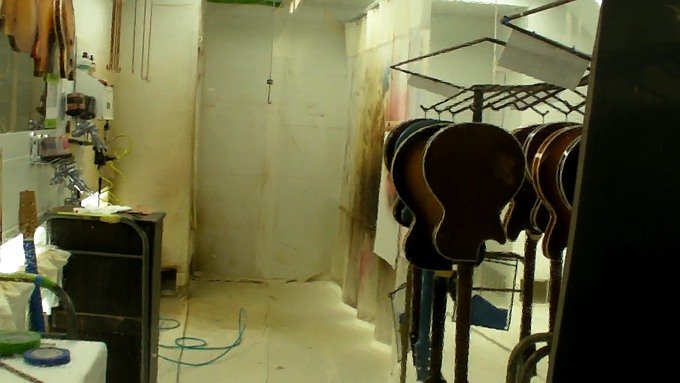-
Posts
1640 -
Joined
-
Last visited
-
Days Won
165
TalismanRich last won the day on April 18
TalismanRich had the most liked content!
Profile Information
-
Gender
Male
-
Location
The Derby City
TalismanRich's Achievements
-
I also like the fact that he brings up the advertising aspect. One of the things that was always a weak point for Heritage was advertising. It's the old "lamp under a bushel" syndrome. If people don't know know about you, they won't seek out your products. It would be interesting to compare the two guitars. I don't particularly like a really tall fret. I feel like I press too hard, which makes things go sharp if the frets are tall. Maybe my grip is too strong, but I've always played that way. I liked the way the pickups sounded. I tend to favor a neck or both pickups. The bridge always sounds too thin for me. That one had a bit of beef on the bottom, which sounded nice to me.
-
When I first got my 535 it had a pretty significant smoke smell. I used Febreeze on the case a few times along with a fan blowing on it. For the guitar itself, I had air blowing in one side for days on end, which lowered it quite a bit. I also tried spritzing some Febreeze inside the hole... I don't know that it did a lot but it masked a bit of the smell. Eventually, the smell diminished and now it's fine. You can get a small USB powered fan that you could use to blow air into one F-hole. Just let it run for as long as you want. I had an old computer CPU fan that ran from a 12v power supply. Some people say that an ionizer or ozone generator works, but you don't want an ozone buildup in your house. If you could put it in a garage or something, it might be ok.
-

Heritage H150 traditionally best built years/eras?
TalismanRich replied to hopkinwfg's topic in Heritage Guitars
One problem with trying to nail down the best guitar by year is that they never really seemed to nail down a "spec change" vs year. Lots of 150s were customized to some degree, and parts used were pretty consistent over the years, at least until Schaller exited parts of the market. Schaller pickups and bridge hardware, Vishay caps, Grover tuners, Jesco frets were pretty much standard items until the mid/late 2000s. Then they went with SD59s or Seths, and a TOM bridge style. The CC series were a departure in many regards, based on Edwin Wilson's specs. There were variations in the neck thickness but they would accommodate requests. The necks were rolled by hand. They have some templates to use as guides, but they didn't vary drastically. I have guitars built in 87, 2000, 2003 and 2005. The necks are reasonably close, somewhat thin for some people's taste but I think they are very comfortable. There are guitars built with chunky necks if the person ordering asked for it. As Dave and Kuz said, judge each guitar on a "case by case basis". -
I've always liked the T5. I played one years ago and it felt very comfortable, and it had a large variety of sounds. I've considered buying one, but I really don't have a need. If I was playing out I probably would have grabbed one. Having a passable acoustic sound as well as electric sounds would be great for live work. If anything, Heritage has proven to be a pretty traditional company. They have done some radical designs years ago, (Little One, SAE, Kahuna, HB1 and 2, Mark Slaughter, etc) but they have never been big sellers. Their bread and butter styles are the solid body LP style, the semi, and the archtops. The Millennium is a pretty unique design, but apparently it wasn't a good enough market to keep it in the lineup, although I've heard a few "maybe" comments. While they did some acoustics early in the company history, it was never a focus. Building acoustics seems to be a different "technique". Some acoustics had bodies made by another company, with a Heritage neck and finishing. I also don't know that they have a production room to do an acoustic series. Even Gibson does it's acoustics in a totally different location from it's electrics.
-
I can't see Heritage going with anything other than solid rim and carved body. Plus when they do the laminate for the 535 and 525s, they use basswood and maple to make the laminate if memory serves me. They may just be using select pieces of maple to do the body vs "standard" maple.
-
I think the fret wire is standard Jesco stuff. It's pretty much used industry wide, unless you go with stainless. I don't remember the number, though. The caps in most Heritages are Vishay MKT metalized film. They are yellow axial capacitors and are good caps. The pots can vary over the years, depending on availability. They use standard audio taper pots. I have tried changing pots and to be honest, sonically there was no change. I had one that was scratchy, so I replaced all 4 with CTS pots. The only difference was in the feel, as I used low torque CTS with a 15% taper which changes the rate of volume change as you turn the knob. They also made it easier to turn, which might be good or bad, depending on your style. Wire is wire... You can get nice cloth covered vintage style wire, but it won't change the sound. It's pretty and if you want it to look like 1959, then go for it. Jacks and switches are pretty much generic. If they are clean and work, they're good. If they get dirty and noisy, or cut out, then change them out. I've used Switchcraft and cheapos from China and as long as they are quiet and solid, they're fine. Depending on how you like to roll off volume, I added a treble bleed to my 157 for a while. I liked it's effect more than 50s wiring or standard wiring. Here's my 157 control cavity with treble bleeds and the stock pots and caps. As I had changed a noisy switch, I changed the cable running up to the switch with a shielded cable. (the grey stuff).
-
That thing really cries out for a Floyd Rose! 😁
-
If I remember correctly, when they were relocating to the other part of the building, didn't they toss a lot of the old patterns out? Someone had a bunch of Heritage stuff like that on Reverb or Ebay or something. That was a few years back so maybe I'm not remembering it correctly. Does anyone else recall that episode? If that happened, then making new Stats or Parsons Street guitars would truly be a custom build, from sketching it out on the wood plank and putting it on the band saw to shaping the curves of the headstock. It would probably be easier to get and independent builder to make a copy. Granted it wouldn't be a "Heritage" but if you were really hooked on getting a particular style guitar, that would be one way to do it. Probably wouldn't be cheap tho!
-
Welcome LL. The resident "expert" on lefty guitars would be Lefty Alicia. She has been at most of our PSPs with various guitars. Here's her Millennium.
-
I don't know about going back to the old business model. It may have something to do with actually making a profit (silly concept, I know). I'm not privy to the financial status of the old company, but I had heard several times that things were indeed often on a "shoestring budget". There were times that I wondered if the owners even paid themselves. It seemed to be more a labor of love. This isn't Jim and Marv building a few guitars. I'm sure that they make a lot more guitars today than they did 15 years ago. Sweetwater alone has 65 guitars listed. CME has 22 listed. Jay Wolfe has 25. That's just 3 dealers. You didn't really see those numbers years ago. Have you visited the factory? The "big money" helped pay for a new dust collection system that makes the place safer, a humidity and temperature control system, a new spray booth where you don't really have to worry about dust contaminating your fresh lacquer, the Plek machine and more. The old factory, while quaint, was really pretty scary from a EHS standpoint. Lots of dust and wood laying around. The spray booth upstairs was open air, so dirt and dust was floating around. It was also quite dangerous, with nitrocellulose coating the entire booth. That stuff is a lot more flammable than some people realize. The business will need to pay for that upgraded equipment. It wasn't free! To their credit, Heritage is still making archtops (the 575 and Eagle Classic). Try to get a new archtop from Gibson. The last one listed was the Chuck Berry ES 350, but it's discontinued. There are a few dozen people making teles and strats. Fender, G&L, Suhr, LSR, PRS, and ton of low cost import versions.
-

Anime song playing with Heritage archtop
TalismanRich replied to busujiujitsu's topic in Heritage Guitars
I've never heard of the song, so I looked up the original on Youtube. I can see how it could get stuck in your head. Its one of those slightly silly tunes that are perfect for being an viral internet hit. Adding the cat video is perfect for the song, and as usual, your playing is impeccable. Nicely done. -
I agree with bringing back the 157 and also the 555. It doesn't require any significant tooling differences, compared to doing something like the Stat or 127. Binding, inlays and gold hardware are the major differences. Sometimes I regret not going for an H-150LW, although my Millie does fill the bill pretty well. Harmony has the Silhouette and Jupiter guitars which more similar to a Fender style than a 150 or 535. I was surprised they did away with the 137, as I think it was a good "entry level" Heritage, although the price wasn't exactly cheap. I don't know the reasoning for discontinuing it, unless it didn't have the profit margin that a 150 has. I would think it had a lot less labor involved with not having all the binding and carving. The 357 will be a stretch. Watching Marv show all the parts that went into making the body, with the neck through center section and the wings means that there is significant effort involved. There may also be some restrictions with the Gibson agreements. I guess the question is "if they build it, will it sell?"
-
I wonder what they have done that is different from the standard line, other than the headstock size, inlays, pickups and pick guard.
-

A meaningless ? Why such wide binding
TalismanRich replied to michaeljames's topic in Heritage Guitars
The binding on my H140 is about 1/16 of an inch. My 535 is slightly thicker than the 140. I think I remember Heritage buying 90 thousandths binding, but then after painting, all binding is hand scraped, so it will be somewhat thinner than that. You might lose 1/4 of that original .090. Of course the hand scraping won't be absolutely consistent, the thickness will vary depending on how much has to be removed to get a clean surface. I don't see anything unusual at all about that one. -

Can you identify this '03 Heritage finish?
TalismanRich replied to michaeljames's topic in Heritage Guitars
You're right, Rob. That looks a lot more like my Chestnut Burst Millie LE but with even more red in the middle..









